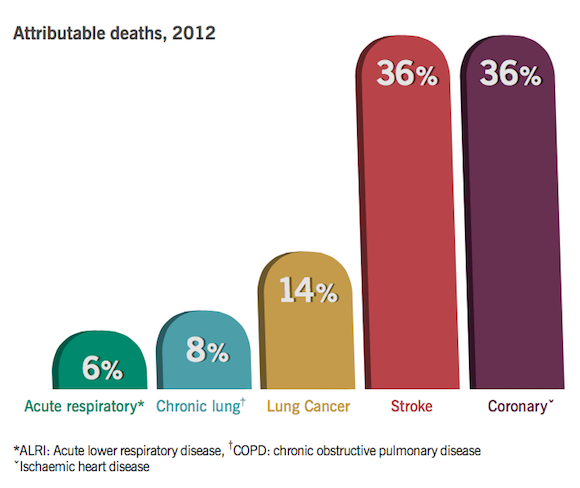Ozone flare
A dangerous gas where the trend is going the wrong way
A generation ago, Britain’s city-dwellers thought of local air pollution as a problem that was on the way to being licked—the smogs of the 1950s were fading from memory. But some forms of pollution have got worse since. Ozone doesn’t sound scary: it’s made out of oxygen, and occurs naturally, especially very high up, in the “layer” that shields us from the sun’s ultraviolet rays.
But this pungent gas is also created closer to the ground in reactions between sunlight and other pollutants, especially on hot still days. Urban ozone is now at almost double 1988 concentrations. The molecule, O3, has three atoms, not the usual two, which makes it unstable. It reacts with all sorts of things, including inside the body, where it causes lung problems.
Source: Department for Environment, Food and Rural Affairs
NO2 go zone
Central London has the world’s worst problem with this gas
Nitrogen Dioxide, or NO2, is a sharp-smelling gas formed by burning fossil fuels; most of the NO2 in city air comes out of vehicle exhaust pipes. Breathing in large amounts of the gas can have serious respiratory consequences. It inflames the lining of the lungs, increasing susceptibility to infections, wheezing, flu and bronchitis, especially for asthmatics. NO2 also speeds up the formation of smog which can in turn cause further complications.
The European Environmental Agency recorded the highest concentration of NO2 in Europe on the Marylebone Road, in London. In 2014, King’s College, London, stated that many roads in central London had the highest concentrations of NO2 anywhere in the world.
Source: European Environment Agency, 2014 data from official monitors
Ashes to ashes, dust to dust
Filth in the air does for hearts, lungs, brains—and lives
The biggest killer is not any single, sinister chemical, but “Particulate Matter,” which is anything that’s floating about. Smaller particles spell bigger trouble. “PM2.5”—specks of less than 2.5 micrometres across—penetrate deep into the respiratory system. Fossil fuels, particularly diesel, are a huge source of particulates, which can cause strokes, heart attacks and cancer.
There is, the World Health Organisation (WHO) says, “no evidence of a safe level of exposure.” The WHO attributes 3.1m deaths globally to PM2.5 in 2010; an official UK report put the British death toll from particulates at 29,000 then. The WHO also includes other (less lethal) pollutants in ambient air, and then breaks down the total death toll. Coronary heart disease and strokes are the principal culprits, with lung cancer third.
Source: World Health Organisation
A dangerous gas where the trend is going the wrong way
A generation ago, Britain’s city-dwellers thought of local air pollution as a problem that was on the way to being licked—the smogs of the 1950s were fading from memory. But some forms of pollution have got worse since. Ozone doesn’t sound scary: it’s made out of oxygen, and occurs naturally, especially very high up, in the “layer” that shields us from the sun’s ultraviolet rays.
But this pungent gas is also created closer to the ground in reactions between sunlight and other pollutants, especially on hot still days. Urban ozone is now at almost double 1988 concentrations. The molecule, O3, has three atoms, not the usual two, which makes it unstable. It reacts with all sorts of things, including inside the body, where it causes lung problems.
Source: Department for Environment, Food and Rural Affairs
NO2 go zone
Central London has the world’s worst problem with this gas
Nitrogen Dioxide, or NO2, is a sharp-smelling gas formed by burning fossil fuels; most of the NO2 in city air comes out of vehicle exhaust pipes. Breathing in large amounts of the gas can have serious respiratory consequences. It inflames the lining of the lungs, increasing susceptibility to infections, wheezing, flu and bronchitis, especially for asthmatics. NO2 also speeds up the formation of smog which can in turn cause further complications.

The European Environmental Agency recorded the highest concentration of NO2 in Europe on the Marylebone Road, in London. In 2014, King’s College, London, stated that many roads in central London had the highest concentrations of NO2 anywhere in the world.
Source: European Environment Agency, 2014 data from official monitors
Ashes to ashes, dust to dust
Filth in the air does for hearts, lungs, brains—and lives
The biggest killer is not any single, sinister chemical, but “Particulate Matter,” which is anything that’s floating about. Smaller particles spell bigger trouble. “PM2.5”—specks of less than 2.5 micrometres across—penetrate deep into the respiratory system. Fossil fuels, particularly diesel, are a huge source of particulates, which can cause strokes, heart attacks and cancer.

There is, the World Health Organisation (WHO) says, “no evidence of a safe level of exposure.” The WHO attributes 3.1m deaths globally to PM2.5 in 2010; an official UK report put the British death toll from particulates at 29,000 then. The WHO also includes other (less lethal) pollutants in ambient air, and then breaks down the total death toll. Coronary heart disease and strokes are the principal culprits, with lung cancer third.
Source: World Health Organisation












